|

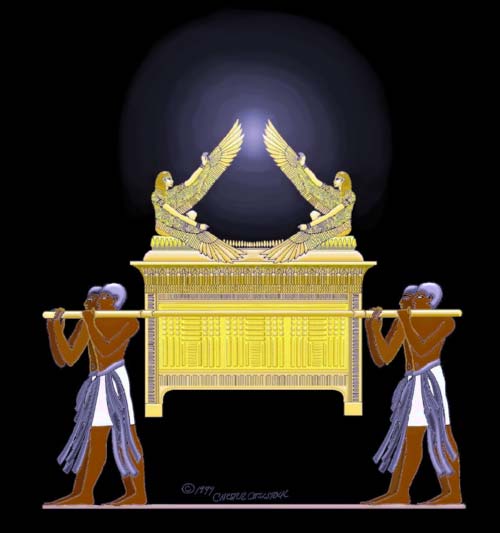
Ark
of the Covenant
THIS IMAGE IS ALSO NOW AVAILABLE AS A
FINE ART
GICLEE PRINT SIGNED AND NUMBERED BY THE ARTIST
Purchase
ARK Prints
Personal note from the artist:
Through out art history many illustrations and
interpretations of the ark have been made. This image was made in
order to satisfy my personal curiosity of what the Ark of the Covenant
may have looked like.
In order to lend a degree of authenticity to my
efforts my approach to illustrating the Ark was to use the artistic
tools, iconography and imagery available to artisans who had received
their training in Egypt during the 13th century BCE.
This premise was used because I reasoned the artisans
who built the Ark for Moses would have been trained in Egypt in
their craft prior to their departure from Egypt during the Exodus
and that the artistic tools and language they would have used would
be the ones they had learned in Egypt while learning their craft.
Therefore this interpretation of the ark is made entirely from iconography
that existed in Egypt on or before 1250 BCE.
The conclusion that the artisans were trained in
Egypt is based on my own life experience in crafting art objects
the hands on abilities to conceptualize and build an art object
are deffinately acquired and not inspired skills.
Exodus 31 Verses 1-11
Then the LORD spoke to Moses, saying: "See, I have called
by name Bezalel the son of Uri, the son of Hur, of the tribe
of Judah. And I have filled him with the Spirit of God, in
wisdom, in understanding, in knowledge, and in all manner
of workmanship, to design artistic works, to work in gold,
in silver, in bronze, in cutting jewels for setting, in carving
wood, and to work in all manner of workmanship. And I, indeed
I, have appointed with him Aholiab the son of Ahisamach, of
the tribe of Dan; and I have put wisdom in the hearts of all
who are gifted artisans, that they may make all that I have
commanded you:
"The tabernacle of meeting, the ark of the Testimony
and the mercy seat that is on it, and all the furniture of
the tabernacle; the table and its utensils, the pure gold
lampstand with all its utensils, the altar of incense, the
altar of burnt offering with all its utensils, and the laver
and its base; the garments of ministry, the holy garments
for Aaron the priest and the garments of his sons, to minister
as priests, and the anointing oil and sweet incense for the
holy place. According to all that I have commanded you they
shall do." |
This page and the associated pages are presented
to share the circumstances under which I undertook this task and
the information I used to make this image. You may not agree with
what is presented however please understand that I undertook this
project for my personal edification. This is truly a work in progress
because I have yet to close the book on the project.
| Text and images are copyright
protected
For permission to reproduce please contact:
Comstock Sculpture Studio Email: chester058@artsales.com
Copyright © 2000 by Comstock Sculpture Studio
Online Edition Copyright 2001 by Chester Comstock |
This Concept is a Work in Progress to be reproduced
as a life sized sculpture in which the Ark ( rectangular container)
will be 46 7/8" X 28 1/4"

List
of Recommended Reading
Ark of the Covenant On
the
In December of 1998, an official of
a church in Denver Colorado ask me to do an interpretation of the
Ark of the Covenant, as I thought it might have looked. After receiving
this request my objective and focus became to come up with what
I considered to be an authentic illustration of the Ark of the Covenant.
My research basically consisted of
finding as many illustrations of the ark as possible and to see
what props Hollywood had come up with during the making of films
about the Exodus. One of the really fun parts of doing this research
was to review films that had been made about this period in history.
My Blockbuster account was in constant use for several months while
I reviewed as many movies as they had in stock about the Exodus
Period. By the way the movie " The Ten Commandments" which
you might think would have an Ark in it never shows the Ark among
the Hebrews.
During my research, I found a great
many illustrations of the Ark but clearly the most prevalent tendency
was for the artist to use artistic conventions and standards from
their own geographic local and historic time frame and not those
of Egypt in the period 1220 BCE which is the chronological time
frame judged by some scholars to be the approximate date of the
Exodus.
Although I felt challenged by the task, I felt particularly
well prepared for this assignment. I had been studying Middle
Eastern art and antiquities as an avocation associated with my
art career for about eight years before talking to the Pastor
at the church. In addition to having a basic knowledge of art
History one of my primary areas of interest before getting this
assignment had been to focus in my Bible Studies on the chronological
comparison of historic Egypt with the biblical accounts of the
patriarchs of the Hebrews during the historic period of the Jewish
sojourn.
SEE: "Timelines
and Events of the Hebrew Sojourn"
Once challenged to come up with a
likeness of the Ark I had a strong personal interest in determining
what the appearance of the ark might have been. In order to handle
this project I spent another six months of study focusing on determining
the language and iconography used in Egypt during the approximate
historic time frame of the Exodus with the objective of illustrating
the Ark of the Covenant in an authentic way. After doing this added
research and after looking at other artists concepts of the Ark
I had failed to find any illustrations of the Ark that passed my
critical review and I realized that I was applying a logic train
that went something like this:
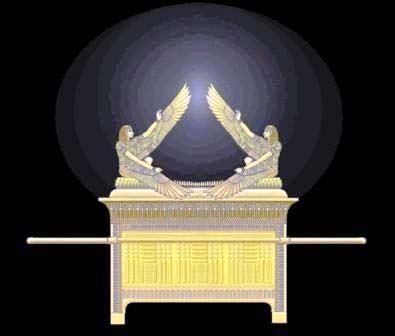
Ark of the Covenant Illustration
done using
13th century BC Egyptian Iconography
Order this Print
|
|
|
|
|
|
|
|
|
|
|
|
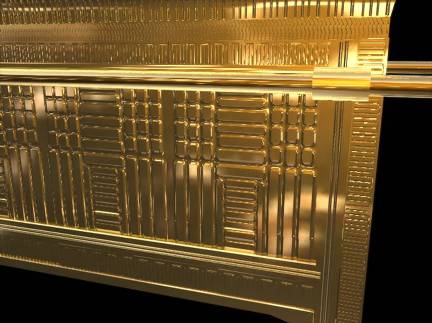 |
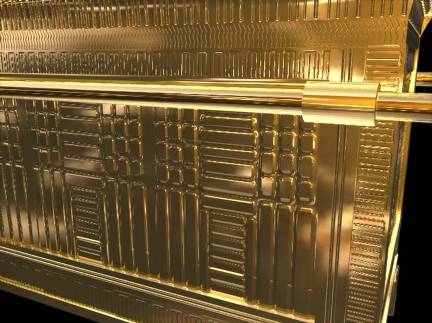 |
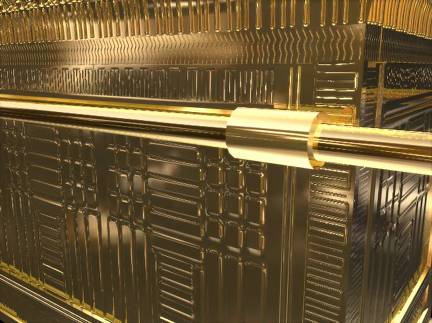 |
|
Illustration done in Cinema 4D
|
The Hebrews having lived in Egypt
for over two hundred and fifty years and having just left Egypt
would have been influenced conceptually in their thinking and art
by what they had seen and heard in Egypt, particularly Moses.
The ark is said to have been built
shortly after the Exodus occurred, therefore the craftsmen who were
commissioned to build the Ark would have learned their craft in
Egypt. With both of these considerations in mind I reasoned it is
highly likely the conventions and imagery used to build the Ark
would have been totally consistent with conventions used in Egyptian
art on or before 1220 BCE. I reasoned that if I wanted to know what
the Ark would have looked like I should apply only the conventions
of Egyptian art from the historic time of the Exodus to the illustration
of the ark and I reasoned that an illustration of the Ark using
these standards of iconography and morphology would be consistent
with its use and meaning within the Hebrew culture.
So the basis for for finding out what
the likely appearance of the Ark was became " use the Iconography
that existed in Egypt on or before the historic date of the Exodus
to do my illustration."
With this standard being the criteria
for creating my illustration the next step was to learn the conventions
in use within Egypt at this historic time frame and to strictly
discipline myself to use these and only these conventions in the
creation of my illustrations and prototypes of the Ark. I have been
criticized for making the ark look Egyptian however, the artisans
that made the ark would have learned their craft in the Egyptian
craft guilds that existed in Egypt and I reasoned those are the
only set of artistic tools they would have had to create the Ark.
There is little need to speculate
about what the guilds were like at the time of the Exodus, there
are Middle Egyptian tomb paintings that clearly illustrate the activities
in the craft guilds. The nobleman who ran the guilds for commerce
used these illustrations to decorate their tombs as a way of saying"This
is who I am, the man who organized and ran the craft guilds for
the king."
The Biblical account of the patriarch
Joseph tells us he was vizier in Egypt during the middle kingdom
period. It is noteworthy that these tombs illustrate the duties
performed by an Egyptian official in a similar position.

Craftsmen Guild Building Golden Shrines illustrated in tomb of Rekhmire,
Rekhmire was 'Governor of the Town' (Thebes) and 'Vizier' during
the reigns of Tuthmose III (1479-1425bce)
and Amenhotep II (1427-1393bce)of Dynasty XVIII.
Although you may not agree with
my thesis, The illustration of the Ark, on these pages, is the full
development of the concept of how the Ark may have been illustrated
by an artist using the conventions of Egyptian art in the historic
period of 1220 BCE. The second consideration I have in my favor
was the fact that I had trained for thirty five years to create
sculptural art and have some instincts about how readily an artist
can switch styles based on inspiration alone. It would be fare to
compare my initial illustration to a modern blueprint made in preparation
for the crafting of the art object. I have often received from clients
a fully illustrated blueprint of an art object that they have wanted
to have built.
The image below is offered to illustrate my analysis
of how most artists have approached the illustration of the Ark
for their particular culture and society. For a brief comparison
of what is known in art history today as to what was know in a
previous era see below the 17 Century Biblical Illumination of
1 Samuel 5:1-7 done by french neo-classical artist Nicolas Poussin
(1594-1665). This Biblical illumination is of the story of the
the Philistines stealing the Ark and taking it to their coastal
cities of Ashdod, Askelon and Gaza.
Poussin was considered to be an academian of
his time however based on what is known today about the history
of Hebrew and Egyptian Art this illustration does not demonstrate
much of an understanding of 12 century BCE art but instead uses
the neo-classical style preferred by the French Aristocracy of
the 17th century. It is therefore the neo-classical style that
dominates this illustration. The neo-classical style has its artistic
roots in Roman and Greek art and the Italian Renaissance which
is a world removed from 12th century BCE Egypt and the time of
the Exodus.

"The Ark Of Ashdod" 17th Century French Neo-classical
Biblical Illumination of 1 Samuel 5:1-7
By Nicolas Poussin (1594-1665)
About Egyptian Art of the 12 century BCE:
It is a characteristic of Egyptian
art that nothing in the compositions was left to chance. Within
Egyptian illustration, every gesture, symbol and glyph has a very
specific meaning and the meaning of the whole is often enhanced
significantly depending on the additive nature of its parts. As
I built this illustration I couldn't help but marvel at the cumulative
significance and consistency the Egyptian symbols had with literary
and scriptural references to the Ark.
It is characteristic of Egyptian iconography
within an illustration to be read as if it were part of a text.
The way the iconography is read and applied to an illustration creates
its own meaning. These subtleties are rooted in the fact that the
Classical Egyptian language was written in Hieroglyphics. The phonetic
aspects of Hieroglyphs and their meaning often were directly derived
from pictographs and iconography, making the language replete with
double meaning and pun. The ancient Egyptian language was very conservative
in its evolution throughout its history and remained the instrument
of the scribes and the ruling classes. It was not until much later
in history at approximately the time of the creation of the Phoenician
Alphabet and its derivatives languages that words were written entirely
phonetically and with no pictorial references.
At this point in time after the evolution
of language away from the formal Hieroglyphic texts it appears that
written language become more egalitarian in its general use and
application, however the majority of the populous in any given culture
remained illiterate.
In order to understand the approximate
chronology of events relating to the Hebrew sojourn look at the
"Timelines
and Events of the Hebrew Sojourn" superimposed
on a Historic Chronology of The Pharaohs of Ancient Egypt"
The evolution and blending of Biblical
chronologies and historic chronologies remains one of the hot topics
for research and development within the scientific and religious
communities. Unfortunately often these disciplines are at odds with
one another in coming to logical conclusions concerning the most
obvious and needed corrections. Fortunately as an artist I can take
and blend the best of both worlds and not feel like I have somehow
compromised my integrity.
Many questions about the origins of
the earliest scriptures arose as a result of this inquiry which
are still unresolved. The most interesting of these questions came
from doing a critical analysis of the time frame and locations of
the development of written languages.
One of the most interesting questions
was in what language did Moses record the Pentateuch? Most historical
evidence points to the fact that Hebrew was developed as a written
language in the seventh century BCE, balancing this fact with the
fact that Moses is credited with writing the Pentanteuch during
the Wilderness experience becomes problematic. I had to conclude
that he may have written his inspirations in an Egyptian script
that was later translated and recorded into Hebrew by other scribes.
Other questions arose from examining
the chronology of events and the comparative analysis of known events
in the histories of Egyptian and Aegean Cultures during the time
frame of the Exodus and occupation of Canaan.
The results of some of these studies
done during my analysis are featured in other articles within this
web site and others will be published in the future.
See Links to other related research:
|
|
|
| |
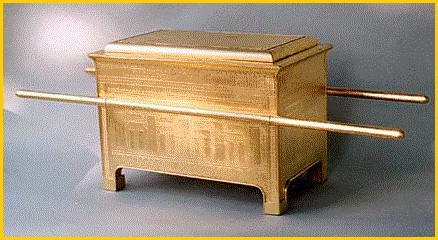
Model of the concept to be built as a full sized replica
of the
Ark of the Covenant
|
Some of the meanings conveyed
within the Egyptian iconography as applied to the illustration
of the Ark are:
-

The primordial waters:
In Graham Hancock's book "The Sign and the Seal" he
mentions the metaphorical comparison of the Ark to the Virgin
Mary. This comparison is a traditional metaphor that is extremely
well developed in the Roman Catholic liturgy. In a sense a woman's
amniotic fluids can be compared to the primordial waters of
creation. In fact, universally life still comes forth from this
source throughout nature. For Christians the metaphor becomes
that through Mary the living word came forth from the womb as
the Ark was a vessel for the word of God.
-

Lotus Flowers, Water Lily:
Life, healing and resurrection.
-

Palace or Royal Dwelling:
Traditionally Ark was God's dwelling place among the Hebrews.
During my research it was interesting to note this decorative
border is used extensively in the Tutankhamen burial shrines.
-

Throne Glyph:
The throne of God, a place of Judgment and meeting place with
God. This symbol could also represent graphically the Mercy
seat.
-

The figures in a gesture of worship and adoration:
-

Proportions of the Golden Mean:
5 parts wide to 3 parts high and wide.
Although the discovery of the Golden mean is often credited
to the Greeks. These proportions are found consistently throughout
Egyptian art and were considered sacred. The story of Moses
(1250 BCE) being instructed by God to make the Ark according
to these proportions is not the first record of these proportions
being considered sacred. By example and historic record the
use of these propotions in sacred objects predates the constuction
of the pyramids of Giza. For example there are various stone
sacophogous which predate the pyramids of Giza that were bulit
according to these proportions. Examples are commonplace if
you look for them.
More specifcially these proportions are found in the construction
of the funerary shrines in Tutankhamen's tomb. It is interesting
to note that the artifacts in this tomb were created fully 200
years before the Exodus occurred. It is evident these proportions
were clearly recognized and used consistently by the Egyptians
in their sacred furnishings, shrines and temples long before
the time of Moses. Although the best evidence of this is shown
in the Tutankhamen shrines in their entirety I'm sure the proportions
were canonized as sacred within Egyptian art long before the
time of Tutankhamen.
As an example of the use of these proportions as sacred, they
were later used as the primary dimensions in the Greek design
of the Temple of Dendera built during the rule of Egypt by the
Ptolemy's .
These proportions have remained an important standard in art
and architecture. You may want to do a study on the use of Golden
mean it art and composition.
-

Spiritual Gateway:
The grove of sycamore trees representing a gateway, in this
context it is a spiritual gateway.
-

Clenched Fist:
Signifying the feminine aspect of creation.
-

Hand held in position signifying worship:
Wings of Cherubim held in the symbolic gesture of protection
and safety. These figures represent Cherubim as the heavenly
worshipers and messengers of God.
-

The priests carrying wear belts with trailers made of snake
skins:
These belts are symbolic of the conquering of mans lower nature,
very much in the tradition of St. George slaying the Dragon,
one of my favorite Christian Icons.
-
The Ark is symbolically a vessel or vehicle,
an Ark of transport to carry God's law, which can be likened
to the belly of a boat used as a ceremonial shrine. This convention
was commonly used in Egypt, and boats were one of the most common
forms of transportation used for spiritual ceremonies in Egypt.
Many people have speculated that the Ark magically
functioned as a transmitter-receiver. At the very least it was
point of contact between God and the Hebrew priesthood. Which
is a spiritual power supply only the initiated would have fully
understood.
The next step was to apply these conventions to
my illustration and to strictly discipline myself to use these
and only these conventions in the prototype of the Ark. The line
drawing of the Ark, on these pages, is the result and my concept
of how the Ark may have been created by an artist using the conventions
of Egyptian art in the historic period of 1220 BCE. When viewing
this concept remember that in the development of Egyptian classical
art nothing was left to chance and artists were trained to employ
conventional standards.
Within Egyptian illustration, every gesture, symbol
and glyph has a very specific meaning and the meaning of the whole
is often enhanced significantly depending on the additive nature
of its parts. The better the artist the more meaning could be
rendered to a topic or illustration. As I built this illustration
I couldn't help but marvel at the cumulative significance and
consistency the Egyptian symbology had with the meaning assigned
to the Ark within literary and scriptural references to the Ark.

Corner Detail from working Model
I am currently transcribing my line drawings into
three-dimensional models of 1/5 and 1/10 scales. The actual dimensions
of the model are 1/5 scale 10" x 6" x 6" inches
and 1/10 scale 5" x 3" x 3" inches. I am creating
the models because I feel the models would have some appeal to
Christians, Hebrews and definitely Egyptians both in Israel and
Egypt. I stand half done with the models having the cherubim yet
to complete. It may not be possible to find the actual Historic
Arc, but I have satisfied to a large extent any curiosity that
I had of what its likely appearance of the arc may have been.
If you think you would like to participate financially in the
creation of a full-scale replica of this concept contact me and
I will explain the procedure.
Chester Comstock
For further information about the Ark of the Covenant: Timelines
and Events of the Hebrew Sojourn superimposed on a Historic
Chronology of The Pharaohs of Ancient Egypt
A selection of information
collected about the Ark compiled by Gerald N. Shapiro

|
